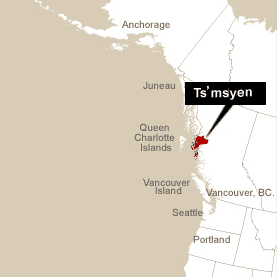
[A newer speller of the Tsimshian popularion is Ts’msyen. However, the following text was taken from the Metlakatla Indian Community website and uses the older spelling.]
“Aside from the Tlingits, Haidas, Eskimos, Aleauts, and other Alaska Natives that call Metlakatla home is the diminishing Tsimshian population. The Tsimshian are uncompensated, forgotten descendants of the hard working pioneers that carved Metlakatla out of the wilderness. Contrary to the belief that those early Tsimshian pioneers were all of one tribe, the facts show that they were representatives from all tribes within the Tsimshian Nation. Within the mighty nation we find the intricate structure of the tribes, each with its own chief and governing council, and within the tribes we find a closer society, that of the Clans. The Tsimshian have four major Clans with which they identify themselves:
1. The EAGLE or Laxsgyiik
2. The RAVEN or Ganhada
3. The WOLF or Laxgyibuu
4. The KILLER WHALE or Gisbutwada
Long before the Great Flood the Bible speaks of, the Tsimshian Nation was mighty; their legions tell of battles won not by the firing of arrows, but by merely a show of strength in numbers. However, the coming of the flood scattered the Tsimshian Nation up and down the coast seeking refuge in small islands that were once mountain tops. After the waters subsided, the people moved down to the new shoreline to begin life over again. Many returned to the main camp seeking family and friends, but history tells of many that stayed because they thought it was the wish of the Great Spirit that carried them to this new area. Those that returned to the Tsimshian stronghold saw that their strength would no longer be in numbers, but would have to be in a closer unity. Eight tribes, Gitsiis, Giluts¢aaw, Gitwilgyoots, Gitando, Ginax¢angiik, Gispaxlo¢ots, Ginadoiks, and Gitlaan, returned to the Tsimshian stronghold Port Simpson. The formation of a ninth tribe composed of young warriors from each of the eight tribes was united under the leadership of both Chief Hi-Maash of the Gitsiis Tribe, and Chief Tah-Gaash of the Ginax¢angiik Tribe. It was the duty of this special tribe to protect those tribes weakened by the flood. So efficient and well organized was this special warrior tribe that they soon became the aggressors rather than the defenders of the Tsimshian Nation.”
Source: Text Copyright of the Metlakatla Indian Community website
